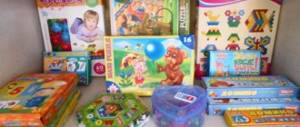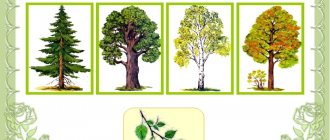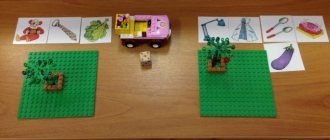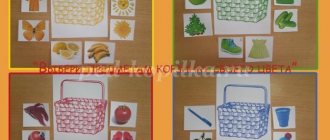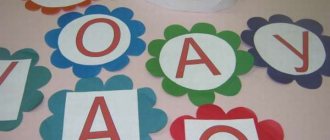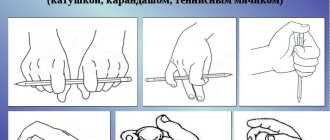Card index of didactic games (second junior group)
Progress of the game
Telling the Russian folk tale “Geese and Swans.” Looking at colorful illustrations for the fairy tale. “Look, guys, what a beautiful, drenched apple tree hid her sister and brother from the evil geese and swans. And now we will also grow a magic apple tree, all filled with ripe, sweet apples and treat it to our dolls. Let's put it on their plates. But our dolls are of different sizes, so we will have to put the apples in 3 different baskets: the largest for Alena; Average for Olya; Small ones for Katya. Now you and I will say the magic words, and a real apple tree will grow on this tray. You just need to say the magic words to everyone: Creebledcrabblebooms. So our apple tree has grown. I show the children an apple tree with apples and baskets. I plant three dolls near the baskets. “Our apple tree grows apples of three sizes. Now each child, in turn, will go to the apple tree and, following the pattern, pick the same apple that is in his hands. If the apple is picked correctly, please put them in the appropriate basket.” When all the apples have been picked and placed in baskets, the children take the apples to the table and continue to treat the dolls. If the game is over, and the children have not yet played enough, then the apples can be hung back and the game repeated.
“What is the difference between the pictures”
Target:
strengthen children's ability to find differences in two identical pictures, develop children's eye, cultivate attention and observation.
Equipment:
2 identical pictures - the plot is the same, but the difference is that in one of them some objects differ in size, i.e. some object is taller than the previous one, some is thicker, and the third is generally shorter, etc. 4–5 sets of pictures.
Progress of the game
The teacher hangs 2 seemingly identical pictures on the board and invites the children to find the differences. Children carefully look and name the differences one by one. For each correct answer, the teacher gives out chips. In the same way, children look at other pictures. Game continues. The one with the most chips wins.
"Butterflies and Caterpillars"
Target:
teach children to sort objects by size, teach them to quickly and thoughtfully perform their actions.
Equipment:
figures of apples and flowers, increasing in size.
Progress of the game
Children are divided into two teams: one is called “Butterflies”, the other is called “Caterpillars”. Three tables are used for the game. On one of them there are figures of apples and flowers, on the other two teams will place their figures. Children line up in two columns. At the teacher’s command, the game begins: the children standing first in the columns run up to the table, choose the largest figurine lying there: “Butterflies” - a flower figurine, “Caterpillars” - an apple figurine, run up to their table and place the figurine there on the left edge table, then return to the column and stand at the end. The next pair of children choose the largest ones from the remaining figures, run to their table and put their figures after the ones that are already lying there. The game continues until all the figures are stacked in descending order. After this, the order of the laid out figures is checked and errors, if any, are corrected. The winner is the team that was the first to complete the task without errors or made fewer mistakes than its opponents.
Card index of didactic games for speech development on the topic “Winter” for the older group
Svetlana Kazmina
Card index of didactic games for speech development on the topic “Winter” for the older group
1. Didactic game “Which, which, which?”
.Goal: to teach how to select definitions for an object, phenomenon. Game rule: the teacher
(possibly children)
names an object, and the children take turns naming as many features as possible that may be inherent in this object. For example: A squirrel is fluffy, red, nimble, small, beautiful... Coat - warm, winter, new, long, short, blue... Snow - cold, white, fluffy, light, crumbly, sticky, etc.
2. Didactic game “What happens?”
.Goal: to teach to classify objects by color, shape, quality, material;
compare objects, compare; select as many names as possible that fit the given definition. Game rule: the teacher invites the children to tell Dunno what happens... For example: new - fur coat, felt boots, hat, coat...; winter - day, morning, evening, forest, weather, clothes, shoes...; fluffy - snow, squirrel, fox, cat, fluff, Christmas tree, hair, jacket, scarf...; cold - tea, snow, milk, ice, weather, wind, winter , room, gloves, ice cream, icicle, compote...;
white - snow, milk, etc. 3. Didactic game “Match the attribute to the object”
.Goal: to teach to agree adjectives with nouns. Game rule: the teacher invites children to answer the questions which, which, which? For example:
winter (which)
- snow-white, white, frosty, harsh, snowy, fierce, icy, cold, windy, elegant , fabulous, wonderful, brilliant;
ice (what)
– transparent, strong, thin, smooth, slippery, cold, fragile...;
skis (what kind)
– wooden, beautiful, smooth, slippery, etc.
4. Didactic game “Match the object to the attribute”
.Goal: to learn to coordinate adjectives with nouns. Game rule: the teacher asks the children to name an object that matches the word... For example: snowball, house, bun, whirlwind...; snowy - woman, building, strip, road...; snowy - drifts, buildings, houses, heaps...; snowy - field, etc.
5. Didactic game “What’s extra?”
.Goal: to consolidate knowledge of the signs of different seasons, to learn to clearly express one’s thoughts;
develop auditory attention . Game parvil: the teacher names the season: “
Winter ” . Then he names the signs of different seasons (the day has become short and the night has become long, birds are flying south; snowdrops have bloomed; the leaves on the trees are turning yellow; fluffy white snow is falling). Children name unnecessary signs and explain their choice.
6. Didactic game “It happens - it doesn’t happen”
(with a ball)
. Goal:
to develop speech , memory, thinking, speed of reaction. Game rule: the teacher pronounces a phrase and throws the ball, and the child must quickly answer: frost in the summer - (does not happen)
;
snow in winter – (happens)
;
frost in summer - (does not happen)
;
drops in summer - (does not happen)
;
ice freezes in winter - (happens)
;
in summer, children make bird feeders - (does not happen)
;
in winter streams flow - (does not happen)
in winter we wear sundresses -
(does not happen)
; etc.
7. Didactic game “Invent it yourself”
.Goal: to teach children to compose sentences with a given number of words. Game rule: the teacher offers children supporting words: snow, snowflakes, snowfall, frost. The teacher asks the children to make a sentence of 4, 5, 6 words. The child who is the first to make a sentence receives a chip. For example: In November, the first fluffy snow fell. White fluffs are spinning in the air. It has been snowing outside for several days now. The bitter cold does not allow children to go for walks.
8. Didactic game “When does this happen?”
.Goal: to clarify and deepen children’s knowledge about the seasons. Game rule: the teacher names the season
(
winter ) and gives the chip to the child. The child names what happens at this time of year and passes the chip to the next player. He adds a new definition and passes the chip to the next one, etc.
9. Didactic game “Who knows more words”
.Goal: find and name words with the sound [c] at the beginning of the word on the
topic “
Winter ”
“snow”
begins with this sound . For example: snow, snowman, snowflake, sled, snowfall, snowmobile, sled, Snow Maiden, etc.
10. Didactic game “Seasons”
.Goal:
to develop attention , thinking and speech.Game rule: the teacher names the signs of any season (
winter , spring, summer, autumn) .Children use the signs to determine and name the season.
11. Didactic game “When does this happen?”
.Goal: to consolidate children’s knowledge about the seasons, their characteristic features;
develop coherent speech , attention, resourcefulness, endurance. Game rule: the teacher gives a descriptive story of one of the seasons, the children name it.
12. Didactic game “Words are relatives”
.Goal: to practice selecting words with the same root. Game rule: the teacher names a word (snowman, children select words with the same root.
13. Didactic game “Come up with a proposal”
.Goal:
to develop coherent speech , the ability to correctly construct a common sentence. Game rule: the teacher names the word (
winter ) . children come up with a sentence with a given word.
14. Didactic game “Name it kindly”
.Goal: to learn to form nouns using diminutive suffixes. Game rule: the teacher invites children to choose words with diminutive suffixes for given words on the topic
“Winter clothes”
,
“
Winter ” . For example: fur coat -
(fur coat)
;
snow – (snowball)
;
cap – (cap)
;
frost – (frost)
;
slide - (hill)
, etc.
15. Didactic game “Name in one word”
.Goal: to consolidate generalizing words on the topic
“Winter clothes”
,
“Winter shoes”
. Game rule: the teacher shows
pictures on the topic “Winter clothes”
,
“Winter shoes”
, children name generalizing words for the proposed
pictures .
16. Didactic game “Finish the sentence”
.Goal: to teach how to make common sentences. Game rule: the teacher begins the sentence, and the children finish it. For example: This is the wonderful thing we made...
(snowman)
.
On our site there is... (cheerful snowman)
.
17. Didactic game with snowball “Choose the word”
.Goal: to teach how to select words for given ones. Game rule: the teacher sets a word, and the children select words that characterize the given word. For example: snow
(what kind)
is white, fluffy, light, sparkling, cold, shiny, etc.;
fur coat (what kind)
is warm, furry, fluffy, etc.;
skis (what kind)
wooden, plastic, light, long, etc.;
mood (what)
is cheerful, sad, joyful, etc.
18. Didactic game “Make a sentence from the words of each line”
.Goal: to teach how to make sentences. Game rule: the teacher voices the words, the children must make a sentence. For example: fluffy, covered, trees, snow; top of the head, snowy, on, pine, hat, etc.
19. Didactic ball game “One - many”
.Goal: to teach how to form words in the plural. Game rule: the teacher asks a question while throwing the ball to the child.
The child answers by returning the ball. For example: Some mittens, but many? (Lots of mittens)
.
One coat, but many? (Lots of coats)
.
One jumpsuit, but many? (Lots of overalls)
.
Some felt boots, but many? (Lots of felt boots)
.
One fur coat, but many? (Lots of fur coats)
.
Some tights, but many? (Lots of tights)
.
One hat, but many? (Lots of hats)
.
One down jacket, but many? (Lots of down jackets)
.
One scarf, but many? (Lots of scarves)
.
20. Didactic game “Say the opposite”
.Goal: to teach how to form antonyms. Game rule: the teacher names a phrase, and the child names the opposite. For example: warm morning -
(cold morning)
;
cold wind – (warm wind)
;
cloudy day – (clear day)
;
big snowdrift - (small snowdrift)
;
thick ice - (thin ice)
.
21. Didactic game “Give me the answer - what is missing?”
.Goal: to teach to use
the genitive case in speech . Game rule: the teacher asks - the child answers. For example: There is snow. Why not? (No snow)
.
There is a hat. Why not? (No cap)
.
There is a blizzard. Why not? (No blizzard)
.
There are mittens. Why not? (No mittens)
.
There is a snowstorm. Why not? (No snowstorm)
.
There are felt boots. Why not? (No felt boots)
.
There is a snowdrift. Why not? (No snowdrift)
.
There is a fur coat. Why not? (No fur coat)
.
There is ice. Why not? (No ice)
.
There are boots. Why not? (No boots)
.
22. Didactic game “Make a story about winter using a help table”
.Goal: to teach how to compose a story using a plan
(helper table)
. Game rule: the teacher offers children a plan for a description story about winter.
• Sun. (This refers to how the sun warms and illuminates the earth at this time of year)
.
• Sky. (This means what the sky is like at this time of year: cloudy, clear, gloomy, cloudy, etc.).
• Earth. (What does the ground look like at this time of year)
.
• Trees. (Describe the appearance of trees at this time of year)
.
• Changes in the lives of animals.
• Changes in the life of birds.
• People's clothing and shoes.
• Activities of people at this time of year.
• Children's games at this time of year.
23. Didactic game “Choose a lot of action words”
.Goal: to teach how to select words-attributes. Game rule: the teacher invites children to select as many words-attributes as possible to the drawn objects. For example: the sun -
(warms, shines, bakes, rises, falls, etc.)
;
snowflake - (spins, flies, melts, falls, etc.)
;
hare - (runs, jumps, hides, is afraid, is in a hurry, gnaws, escapes, etc.); bullfinch - (flies, pecks, sits, watches, hatches chicks, etc.)
.
24. Didactic ball game “Call it kindly”
.Goal: to teach how to form words in an affectionate form. Game rule: the teacher names a word and throws the ball to the child, who, accordingly, names the word in an affectionate form and throws the ball back. For example: zama-
(winter)
;
snow – (snowball)
;
snowflake – (snowflake)
;
ice- (ice)
;
wind - (breeze)
;
cap – (cap)
;
fur coat - (fur coat)
;
boots – (boots)
;
felt boots - (felt boots)
;
sweater (sweater)
;
trousers – (pants)
;
mittens – (mittens)
;
scarf – (scarf)
, etc.
25. Didactic game “Select, name, remember”
.Goal: to learn to select definitions and verbs for nouns. Game rule: the teacher pronounces the word, and the child
(which one, which one? which ones)
. For example:
winter (what kind)
- cold, harsh, frosty, snowy, blizzard, long
(boring)
and etc.;
snow (what)
- ...;
snowflakes (what)
- ...;
ice (what)
- ...;
day (what)
- ... 4th day
(what)
- ...;
frost (what)
- ...;
snowflakes in winter (what they do)
- fall, curl, spin, sparkle, shine, melt, etc.;
ice in the sun (what does it do)
- ...;
frost (what does)
- ...;
children in winter (what they do)
- ... etc.
26. Didactic game “How many are there?”
.Goal: to teach to coordinate numerals with nouns in gender, number and case. Game rule: the teacher names the numeral with the noun, and the children continue. For example: one snowflake - (two snowflakes, three snowflakes, four snowflakes, five snowflakes, six snowflakes, etc. .d.); one snowman - ...; one icicle - ...; one snowdrift - ...; one snowball - ...; one slide - ... one piece of ice - ... etc.
27. Didactic game “Finish the sentence”
.Goal: to teach how to compose complex sentences with the meaning of opposition. Game rule: the teacher begins the sentence, and the children finish it and repeat the sentence in full. For example: In winter there is snowfall, and in autumn
(leaf fall)
; In winter there is snow, and in summer...; Snow falls in winter, and in summer...; in winter they go sledding, and in summer... etc.
28. Didactic game “What is he doing?”
.Goal: to teach how to select nouns for the named actions. Game rule: the teacher pronounces a sentence and asks the child to correct the mistake. For example: A girl sleeps in a den.
(Bear)
.
Mom runs through the forest in winter. (Hare)
.
The grandmother spread a large snow carpet on the ground and hid the animals under it from the frost. (
Winter ) .
The children came to our yard in winter. (Birds)
.
Grandfather sleds down the hill in winter. (Child)
.
29. Didactic game “An extra word”
.Goal: to promote
the development of auditory attention , enrich the vocabulary and clarify the meaning of words. Game rule: the teacher pronounces the words, and the child must name the extra word and explain his choice. For example: fur coat, boots, skirt, sweater, trousers. (boots - shoes)
;
winter , spring, summer, autumn, November. (November – month)
;
squirrel, hare, bear, tit, hedgehog. (tit – bird)
;
fur coat, scarf, Panama hat, mittens, hat with earflaps. (Panama - worn in the summer)
.
30. Didactic game “How?”
.Goal: to teach children to give a qualitative assessment of actions, answer the question how? Game rule: the teacher invites the children to continue the phrase. For example: The plane flies quickly, but the sparrow flies
(slowly)
.
(quickly)
down the mountain .
Birds sing a lot in summer, and (little)
.
Animals feel good in the forest in the summer, but (badly)
.
The hedgehog is warm in the hole, and the hares under the bush are (cold)
.
In the summer there is a lot of food in the forest, and in the winter there is (little)
.
Thank you all for your attention.
